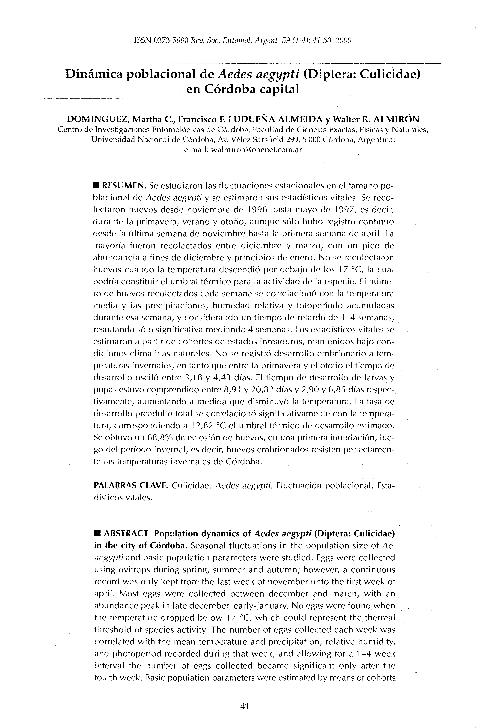Artículo
Se estudiaron las fluctuaciones estacionales en el tamaño poblacional de Aedes aegyptí y se estimaron sus estadísticos vitales. Se recolectaron huevos desde noviembre de 1996 hasta mayo de 1997, es decir, durante la primavera, verano y otoño, aunque sólo hubo registro continuo desde la últirna semana de noviembre hasta la primera semana de abril. La mayoría fueron recolectados entre diciembre y marzo, con un pico de abundancia a fines de diciembre y principios de enero. No se recolectaron huevos cuando la temperatura descendió por debajo de los 17 "C, la cual podría constituir el umbral térmico para la actividad de la especie. El número de huevos recolectados cada semana se correlacionó con la temperatura media y las precipitaciones, humedad relativa y fotoperíodo acumuladas durante esa semana, y considerando un tiempo de retardo de 1-4 semanas, resultando sólo significativa mediando 4 semanas. Los estadísticos vitales se estimaron a partir de cohortes de estados inmaduros, mantenidos bajo condiciones climáticas naturales. No se registró desarrollo embrionario a temperaturas invernales, en tanto que entre la primavera y el otoño el tiempo de desarrollo osciló entre 3,18 Y 4,43 días. El tiempo de desarrollo de larvas y pupas estuvo comprendido entre 8,91 y 20,82 días y 2,90 Y6,85 días respectivamente, aumentando a rnedida que disminuyó la temperatura. La tasa de desarrollo preadulto total se correlacionó significativamente con la temperatura, correspondiendo a 12,82 "C el umbral térmico de desarrollo estimado.
Se obtuvo un 68,8°~) de eclosión de huevos, en una primera inundación, luego del período invernal, es decir, huevos embrionados resisten perfectamente las temperaturas invernales de Córdoba. Seasonal fluctuations in the population size of Ae. aegypti and basic population parameters were studied. Eggs were collected using ovitraps during spring, summer and autumn: however, a continuous record was only kept frorn the last week of november unto thefirst week of april. Most eggs were collected between december and march, with an abundance peak in. late december, early-january. No eggs were found when the temperature dropped below 17°C, which could represent the thermal threshold of species activity. The number of eggs collected each week was correlated with the mean temperature and precipitation, relative humidity, and photoperiod recorded during that week, and allowing for a 1-4 week interval the number of eggs collected became significant only after the fourth week. Basic population parameters were estimated by means of cohorts of immature stages kept under natural conditions. No embryonic development was recorded under winter temperatures, while from spring through autumn the development time varied between 3.18 and 4.43 days. Larval and pupal development time varied between 8.91 and 20.82, and 2.90 and 6.85 days respectively, increasing as temperature dropped, The pre-adult stage development trate was significantly correlated with temperature and was estimated to have a development thermal threshold of 12.82 °C. Eggs containing a fully formed embryo perfectly resist Córdoba's low emperatures, as can be noted in the fact that 68.8% of egg-hatching was recorded for flooding eggs for the first time after winter.
Dinámica poblacional de Aedes aegypti (Diptera: Culicidae) en Córdoba Capital
Título:
Population dynamics of Aedes aegypti (Diptera: Culicidae) in the city of Córdoba
Fecha de publicación:
12/2000
Editorial:
Sociedad Entomológica Argentina
Revista:
Revista de la Sociedad Entomológica Argentina
ISSN:
0373-5680
Idioma:
Español
Tipo de recurso:
Artículo publicado
Clasificación temática:
Resumen
Palabras clave:
Cuclicidae
,
Aedes Aegypti
,
Fluctuación Poblacional
,
Estadísticos Vitales
Archivos asociados
Licencia
Identificadores
Colecciones
Articulos(IIBYT)
Articulos de INSTITUTO DE INVESTIGACIONES BIOLOGICAS Y TECNOLOGICAS
Articulos de INSTITUTO DE INVESTIGACIONES BIOLOGICAS Y TECNOLOGICAS
Citación
Dominguez, Martha Cecilia; Ludueña Almeida, Francisco Felipe; Almiron, Walter Ricardo; Dinámica poblacional de Aedes aegypti (Diptera: Culicidae) en Córdoba Capital; Sociedad Entomológica Argentina; Revista de la Sociedad Entomológica Argentina; 59; 1-4; 12-2000; 41-50
Compartir




